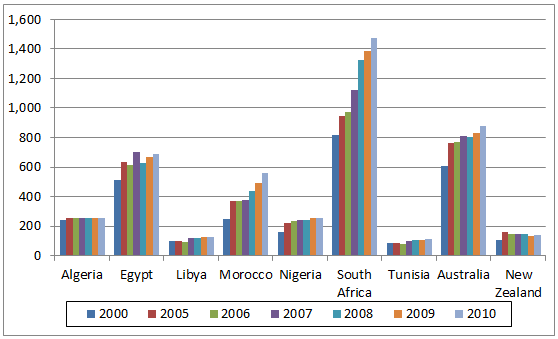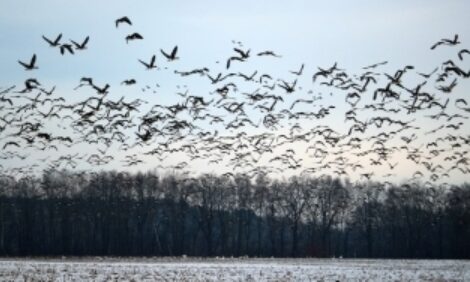



GLOBAL POULTRY TRENDS 2012 - Oceanian Chicken Output Growth Matches World Average, Africa's Exceeds it
Annual growth in chicken output in Africa since 2000 is expected to average 4.4 per cent, compared to the global average of 3.7 per cent, according to Terry Evans. He turns his attention to the future prospects for the chicken industries in African countries and for Oceania, where production has expanded to match this worldwide increase.Africa's Output Heads Towards Five Million Tonnes
Chicken meat production in Africa expanded by 4.6 per cent a year in the decade to 2010, which compares with the global figure of 3.9 per cent. Growth has since slowed such that, based on our estimates for 2012, the annual rate of expansion for the 12 years since 2000 will have averaged 4.4 per cent against a worldwide increase of 3.7 per cent. Consequently, Africa's contribution to the global total has increased from 4.7 per cent to exceed five per cent. In tonnage terms, the regional total is now around 4.7 million tonnes as against 2.8 million tonnes in 2000, while the world total has escalated from a little below 59 million tonnes to almost 91 million tonnes (Table 1). By 2015, Africa's production should exceed five million tonnes.
The most recent data for all the countries in the region (Table 2 and Figure 1) reveals that just seven countries produced more than 100,000 tonnes of chicken meat - table birds plus culled layers - a year in 2010, and they accounted for almost 3.4 million tonnes or 77 per cent of the total for all Africa of nearly 4.4 million tonnes. This is not to say that production in the other countries has stood still. Far from it, as their combined output has expanded from 614,000 tonnes to a million tonnes over the decade.
Clearly, South Africa is the leading producing nation (Tables 2 and 3 and Figure 1), accounting for almost 1.5 million tonnes in 2010 or more than one-third of the regional total. During the 10 years to 2010, chicken meat production in Africa grew by 1.6 million tonnes with South Africa easily the major contributor to the expansion accounting for 654,000 tonnes (41 per cent) of the total.
South Africa's poultry meat industry is the largest individual agricultural industry, contributing almost 18 per cent to its Agriculture Gross Domestic Product, according to a USDA GAIN Report. Table chicken production has expanded by around four per cent annually over the past decade, according to the South African Poultry Association (SAPA). However, the growth rate has contracted sharply recently, reflecting higher feed costs and that a strong Rand has attracted more imports. Hence, chicken meat output in 2012 is unlikely to exceed 1.5 million tonnes.
For 2011, table chicken slaughterings were assessed at 979 million - just one per cent more than in 2010 - while output amounted to 1.37 million tonnes. Slaughterings of culled layers and parent stock added a further 56,000 tonnes to push total chicken meat output up to almost 1.43 million tonnes. Among the challenges facing this industry are: an increase in imports that now represents the biggest single supplier of chicken products in the market; combating higher input costs through increased efficiencies; the continuous threat of poultry diseases, and limited disposable income may have a negative effect on the level of consumption per capita. Hence, it is possible that the industry may witness negligible growth in 2013.
The region's second largest producer is Egypt. Although chicken meat output in this country increased by around three per cent annually over the years 2008 to 2010, production in the latter year, at an estimated 685,000 tonnes, still failed to match the 2007 level of almost 705,000 tonnes. High feed prices and a ban on the transport of live poultry between districts, aimed at preventing the spread of H5N1 avian influenza, are making life difficult for producers.
Since the virus hit Egypt in February 2006, some 60 million birds have been killed. Good news on this front is that the National Research Centre (NRC) in Cairo has manufactured a vaccine against this virus using technology based on genetic engineering. It is claimed that this vaccine has a much higher efficacy than those imported by the government. One report states that the first quarter of 2012 witnessed a sharp drop in production of some 500,000 birds a day as the daily number fell to 1.1 million, which compared with 1.6 million a year earlier.
During 2010, the number of birds killed averaged almost 1.4 million a day. Despite a recession and a high percentage of the human population being poor, the industry is optimistic about growth in the long term. At least one forecasting body has calculated that an expansion of some 17 per cent is possible between now and 2020, which would put production in excess of 800,000 tonnes a year at that time.
The chicken industry in Morocco, third in the production league of African countries (Table 4), recorded a massive annual increase of more than eight per cent as output climbed to 560,000 tonnes in 2010. If this rate can be maintained, annual production will soon exceed three-quarters of a million tonnes.
Of the other nations with annual outputs in excess of 100,000 tonnes, the broiler industry in Nigeria recorded the fastest rate of annual increase at almost five per cent for the decade although recently, this has contracted to less than two per cent.

Oceania Matches World Growth
Production in Oceania, currently at around 1.3 million tonnes a year, accounts for a little over one per cent of global chicken meat production. Annual growth for the decade to 2010 at 3.7 per cent just failed to match the global figure. However, as production in just one country - Australia - represents 84 per cent of the regional total, clearly changes in this country have a major impact on developments in this region as a whole.
Chicken meat production in Australia topped one million tonnes in 2010/11 according to the Australian Chicken Meat Federation. Slaughterings in 2012/13 are forecast at almost 590 million birds, yielding some 1.07 million tonnes of meat. For 2015/16, the number of birds killed is expected to come close to 630 million with output projected at 1.16 million tonnes although a rapid rise in feed prices mid-2012 might apply a brake to short-term growth.
Average slaughter weights have increased by almost 20 per cent in the 10 years to 2010/11 to average 1.85kg. Today, it takes around 35 days to produce a 2-kg live weight bird compared with some 41 days back in 1995. Just two companies account for an estimated 70 per cent of national output, the remainder being produced by a further six medium-sized operations. Approximately 800 growers, under contract to the processors, produce about 80 per cent of national output. It is estimated that some 15 per cent of chicken meat comes from free-range enterprises, a sector that looks set to expand.
After peaking in 2005 at 157,000 tonnes, chicken meat production in New Zealand appears to have contracted towards 135,000 tonnes in 2009. However, 2010 witnessed a recovery to 143,000 tonnes. This seems to have continued such that poultry meat output in 2012 could come close to, and might exceed, the 2005 record of nearly 163,000 tonnes, of which chicken meat could account for some 158,000 tonnes.
Forecasts by America's Food and Agricultural Policy Research Institute (FAPRI) anticipate poultry meat output rising to around 178,000 tonnes by 2020 and further towards 191,000 tonnes by 2025. The corresponding figures for chicken meat would be around 171,000 tonnes and some 183,000 tonnes. As in Australia, the bulk of production is in the hands of two companies. The proportion of free-range production is considered to be small, possibly less than two per cent.
October 2012













